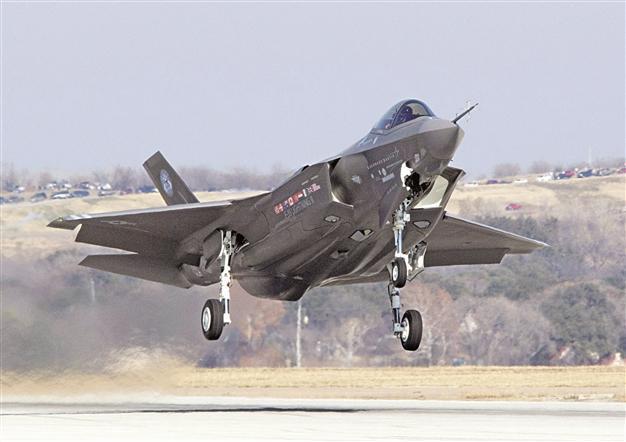Australia to purchase 100 F-35s to boost air power
CANBERRA - Reuters

Australian Defense Minister Stephen Smith says Canberra is committed to purchasing several squadrons of F-35s and would also buy 12 Boeing Co EA-18G electronic attack planes.
Australia announces that it will buy 100 new Lockheed Martin Corp F-35 Joint Strike Fighters, as it is set to turn its focus back to the Indo-Pacific as China and India strengthen their forces. Australia wants to enhance its military challenges in line with the United States pivot towards the Asia-Pacific
Australian Defense Minister Stephen Smith says Canberra is committed to purchasing several squadrons of F-35s and will also buy 12 Boeing Co EA-18G electronic attack planes.
ustralia announced a significant boost to its military air power on May 3, committing to buy up to new 100 Lockheed Martin Corp F-35 Joint Strike Fighters, as it shifts its focus back to the Indo-Pacific as China and India beef up forces.
After more than a decade of having forces first in Iraq, and then Afghanistan, Australia wants to focus on the military challenges closer to home, in line with U.S. President Barack Obama’s 2011 “pivot” towards the Asia-Pacific.
In a new defense strategy, Australia reinforces that the United States remains its closest ally, but also struck a conciliatory tone towards top trading partner China, noting its rising defense capabilities are a natural outcome from its growing economy.
“The government does not approach China as an adversary. Rather, its policy is aimed at encouraging China’s peaceful rise and ensuring that strategic competition in the region does not lead to conflict,” the defense strategy said.
As part of Australia’s military buildup, Defense Minister Stephen Smith said Canberra was committed to purchasing several squadrons of F-35s and would also buy 12 Boeing Co EA-18G electronic attack planes, modified versions of the 24 Super Hornets already equipping Australia’s air force.
“This important decision will assure a first-class air combat capability for Australia through the transition period to the Joint Strike Fighter, which will proceed on its current schedule,” Defence Minister Stephen Smith said.
Canberra’s decision reinforces positive steps for the F-35, coming on the heels of a decision by Norway to buy six F-35s a year earlier than planned, and the Dutch parliament’s decision not to reassess F-35 rivals to replace aging F-16s, despite cost overruns and development delays.
Australia’s first two F-35s are due to be delivered in the United States in 2014-15. Australia will initially buy 14 F-35s, building up to three operational squadrons, of around 75 planes. The first squadron is due in service from around 2020.
The decision to stick with the F-35 will give Australia a mixed fleet of Super Hornets, Growlers and the new stealth fighters, matching the U.S. navy capability until at least 2030, Smith said.
The government also holds the option of buying a further 25 F-35s after 2030, to replace the Super Hornets when they are withdrawn from service, bringing the total of F-35s to 100.
Strategic outlook to focus on Asia-PacificThe new defense strategy is the first reassessment of Australia’s military priorities since 2009, and comes after the 2011 U.S. pivot to the Asia-Pacific. Part of that pivot included U.S. marine rotations through a de-facto U.S. base in northern Australia.
The U.S. troop deployments and Australia’s 2009 military strategy both upset China, particularly when Australia bluntly told China it needed to do more to explain its military plans which it said had the potential to concern its neighbors.
China has sharply increased military spending over the past three decades and its navy is now second in size only to the U.S. fleet in terms of numbers, increasing concerns from neighbors, like Japan and South Korea, involved in a series of long-running territorial disputes.
Australia’s new strategy stresses the need for both China and the U.S. to build their strategic relationship, and says Australia does not believe it will have to choose between its alliance with the U.S. and its strengthening ties with China.
“Certainly there has been a lot of diplomatic varnish put on the text of this white paper, and there is nothing in there that should offend China outright,” said Rory Medcalf, an analyst from the strategic policy think tank the Lowy Institute. “This white paper will certainly be one of the last steps in rebuilding Australia-China relations.”
The document also stresses the growing importance of the Indian Ocean region, with India’s military growth and with two thirds of global oil shipments passing through the Indian Ocean.
Turkey one of F-35 partnersTurkey is one of nine countries that are part of a U.S.-led consortium to build the F-35 fighter. The others are Britain, Canada, Italy, the Netherlands, Australia, Norway and Denmark.
The development of the stealth fighter has been plagued by technical problems that have prompted some countries to cancel, scale back or defer purchases.
Turkey had planned to order 100 units of the stealth fighter to replace its current fleet, consisting mainly of F-4 Phantoms and F-16 Falcons, but it postponed in January the order to purchase its first two U.S.-made F-35 fighter jets due to technical problems and rising costs, but said it still intends to buy 100 more in the long run.
